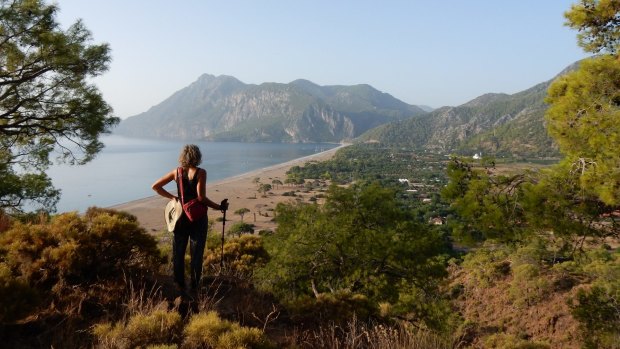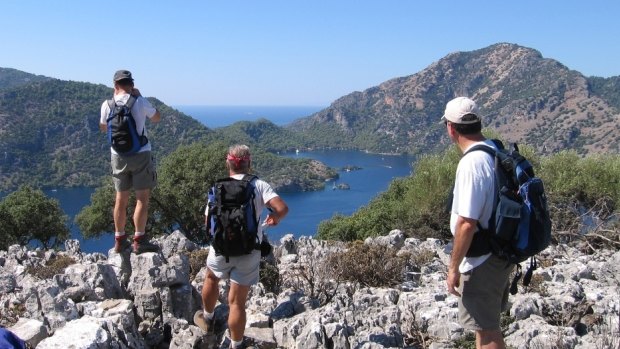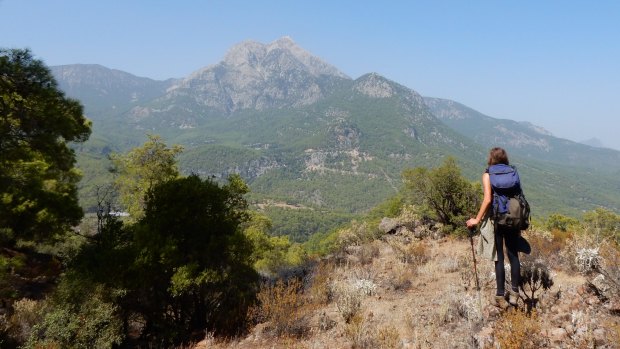This was published 2 years ago
Hiking the Lycian Way, Turkey: Getting lost on one of the world's greatest long-distance hiking trails
By Ben Groundwater

The Lycian Way is way-marked, all 540 kilometres of it ... but you can still take a wrong turn.
There's a point in time when you forget that Antalya even exists. For me it happens in a clearing on a hilltop high above the coastal town of Adrasan. There are a few wooden benches here, roughly hewn and banged together, where you can rest weary legs, take a few slugs of water and just gaze up at the rich blue sky, enjoy the rustle of pine needles and the chirp of birdsong and the knowledge that there's no one else for miles and miles.
Antalya didn't feel like that. It's a strange place: the touristy version of Turkey, though one with history, a tacky, modern Mediterranean resort town that was once inhabited by Greeks, Romans and Byzantines. The old stone-ringed harbour here rocks with party boats blasting Russian techno; Irish pubs and burger joints stand in the shadows of Roman ruins and modern minarets.
Antalya is where my journey begins, my great hike along the Lycian Way. This is a 540-kilometre trail that winds via dirt roads and rough tracks along Turkey's Teke Peninsula to Fethiye, tracing the area's rich history, calling past ruins and burial sites while stopping at the relaxed coastal villages that link these two touristy hotspots.

The scenery over the next few days gets more spectacular, more rugged, more challenging.
I'm not walking the whole thing – it's just a week-long snapshot – but still, it's a challenge that looms large in the consciousness, something I can't help but ponder as I sit on the old stone wall at the Antalya harbour and watch those party boats cruise by, watch as the sun sets over the distant hills I will soon be expected to climb.
Is it really peaceful out there? Is it really untouched? Here, it's hard to comprehend.
If Antalya is good for anything it's stocking up on supplies. I'm filling water bottles here, I'm making up trail mix, I'm buying enough simit – donut-shaped, sesame-seed-covered Turkish bread – and Laughing Cow cheese to see me through tomorrow's 19 kilometre trek. I'm trying to eat local food in a place where everyone greets me with "privyet" because they figure I'm another one of the Russian tourists.

The Lycian Way was researched and developed by British amateur historian Kate Clow in the late 1990s, a heroic effort to protect Turkey's ancient pathways.
And then, suddenly, that world begins to fade. The next day I hitch a lift with Bekir, the local uTracks representative who has put this self-guided itinerary together, to a dirt road just above the town of Tekirova. "You will see a beach that is perfect for your lunch stop," Bekir tells me. "But make sure you don't spend too much time to get to your accommodation before dark."
Sound advice, I think, as I heft my daypack and begin the hike along an old mining access road, a wide, deserted pathway that winds through pine forests that hug an impossibly beautiful coast. Immediately, there's nothing and no one. I walk 12 kilometres on this road, one foot in front of the other, the sun high and the sea sparkling, and don't see a soul.
I pass rocky coves. I see black-sand beaches. And then eventually there's a cairn of stones by the side of the trail and I know it's time to turn left down to one of those beaches, that my lunch spot awaits.
The Lycian Way is way-marked, all 540 kilometres of it. One of the world's great long-distance hiking paths – a trail to match the pilgrims' walks of Italy and Spain – it was researched and developed by British amateur historian Kate Clow in the late 1990s, a heroic effort to protect Turkey's ancient pathways and to bring the benefits of tourism to this otherwise sleepy agricultural part of the world.
I find it takes a little time to get into the rhythm of Clow's way-markings though, to know what to keep your eye out for, to sense where the trail will turn next.
I make my first big mistake just after the lunch stop, when I'm full of simit and Laughing Cow and picturing getting to the next town for a swim. I know I have to pass between two trees; I know there's a riverbed to cross. I know there will be a blue marker. I see all of those things and set off inland, the sun beating down as I wind between huge, rocky hills, waiting for the road to turn back towards the coast, but it just never does.
Eventually, I realise I've gone wrong. I've walked 4 kilometres in the wrong direction. I've turned a 19 kilometre walk into a 27 kilometre slog. I retrace my steps and then stumble along the path I was supposed to follow, a rough, undulating trail that skirts beaches and rounds headlands. I finally make it to Cirali, water bottles empty, simit supply depleted, and heave myself into the small pension where I'll be spending the night.
The owner looks me up and down and then consults his little booking sheet. "Vladimir?"
I spend the next morning relaxing in Cirali, floating in the Mediterranean, taking in the majesty of Mount Olympos on the horizon, enjoying the South-East Asian beach-town feel of Cirali, with its juice bars and mini-markets and laidback attitude.
And then I go and get lost again.
Today is a shorter walk, mostly downhill, from high above Cirali back through the pine forests and into town. I'm supposed to take a left when I reach a rope bridge – only, the bridge doesn't exist anymore.
Things change around here, I'm finding: way-markers fade, landmarks shift, new signs appear as old ones vanish.
It takes a little wandering through the forest before I pick up the painted way-markers again and reach a pass with spectacular views, before going on down through Chimaera, a cluster of small flames that burn indefinitely (the result of a constant trickle of gas) and spurred ancient Greek myths, and back to Cirali.
The scenery over the next few days just gets more spectacular, more rugged, more challenging. The next morning I set off towards Adrasan, a 16 kilometre path that summits two mountains and winds through forests and granite outcrops. The trail at my feet is dirt and pine-needles; the trees keep it shady and cool; I pass one other group of hikers the whole day, Australians who are doing the entire trail from Fethiye to Antalya. Keep going, they smile – you're almost at the top.
I pause at an old shepherds' hut to eat more simit and take in the views of farmland and coastline where Adrasan rests. I stroll down the mountain at a leisurely pace, taking time to rest on those wooden benches and stare at the sky and ponder the difference between the peace here and the hustle of Antalya, the way the rewards are so much richer when you get here on foot, when you put the effort in to reach a place like this and just be.
Tomorrow there's another long walk, past a lighthouse and around a headland, a challenging hike that will test my fitness as well as the conviction that I would rather be here instead of one of those Irish bars in Antalya. But really, there's no question.
THE DETAILS
FLY
Singapore Airlines flies from Australian ports to Antalya – in codeshare with Turkish Airlines – via Singapore and Istanbul. See singaporeair.com
TOUR
UTracks offers walking and cycling trips of varying lengths, guided and self-guided, year-round. The Lycian Way Coastal Walk is an 8-day self-guided itinerary departing from March to May and September to November, from $1280 a person twin share. Phone 1300 303 368. See utracks.com
MORE
Ben Groundwater travelled as a guest of uTracks
FIVE GREAT LONG-DISTANCE WALKS
CAMINO DE SANTIAGO, SPAIN
This is the perfect entry into long-distance walking, a well-marked trail over relatively flat terrain that brings with it a spiritual element, given its history as a pilgrims' trail. The most popular route is a 780 kilometre trundle from the Pyrenees to Santiago de Compostela. caminosantiago.org
MOUNTAIN CRESTS, CORSICA
The "GR20" is one of the hardest walks in Europe, a 180 kilometre slog (with more than 12 kilometre of vertical gain) that runs along a central spine of mountains in Corsica. Most hikers need a couple of weeks to tackle the steep ascents and rocky traverses. See le-gr20.fr
LARAPINTA TRAIL, AUSTRALIA
Australia has some excellent opportunities for long-distance walking, and perhaps none better than the 223 kilometre Larapinta Trail, which follows the West MacDonnell Ranges from Alice Springs to Mount Sonder. The track is well marked, with plenty of campsites. See northernterritory.com
APPALACHIAN TRAIL, US
This is the grand-daddy of long-distance hiking paths, a bucket-list experience for anyone who likes to trek. The Appalachian Trail stretches 3500 kilometre and passes through 14 states, taking in spectacular scenery along the way. See appalachiantrail.org
GREAT DIVIDE TRAIL, CANADA
This is another not for the faint-hearted, a 1130 kilometre track through the Canadian Rockies, hugging the border between British Columbia and Alberta. Most walkers tackle just a small section, which is enough to appreciate the wild grandeur of this part of the world. See creatdividetrail.com
Sign up for the Traveller Deals newsletter
Get exclusive travel deals delivered straight to your inbox. Sign up now.